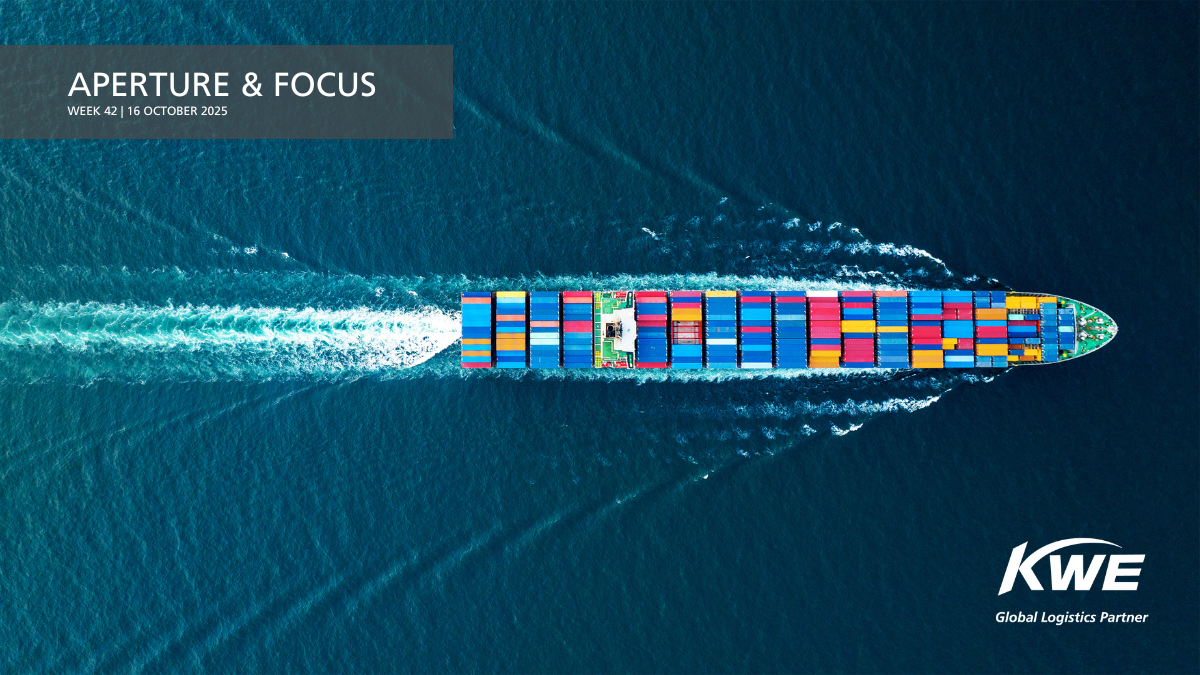Quote
Aperture & Focus 2025: Week 42

Global Aperture
The United States and China began enforcing new reciprocal port fees on each other’s vessels on October 14, escalating trade tensions despite an earlier tariff truce. The measures, which mirror one another in scope and cost, target ships owned, operated, or flagged by the opposing country and are expected to add millions in annual costs for carriers, heightening uncertainty across global trade lanes.
The International Air Transport Association (IATA) reported a 4.1% year-on-year rise in global air cargo demand for August, marking the sixth straight month of growth. The increase demonstrates the continued trend of shippers shifting high-value goods from sea to air to avoid tariff risks and maintain schedule reliability as global trade patterns continue to evolve.
The International Maritime Organization (IMO) held its second Extraordinary Session of the Marine Environment Protection Committee (MEPC ES.2) in London on October 14 to finalize new global rules that would make its greenhouse gas reduction targets legally binding by 2027. Delegates are voting this week on the IMO Net-Zero Framework, which calls for a 20–30% emissions cut by 2030 and 70–80% by 2040, with fuel benchmarks and carbon pricing measures requiring a two-thirds majority for approval.
Regional Focus
Americas
United States: U.S. container imports fell sharply by 8.4% in September 2025, with imports from China down 12.3% month-over-month amid mounting tariff uncertainty and the approaching expiration of the U.S.-China tariff truce. The steep drop, led by declines in key categories like aluminum, footwear, and electronics, reflects both seasonal patterns and heightened sensitivity to shifting trade policies.
Mexico: A new 33.5% tariff on Chinese imports and stricter customs data requirements are disrupting cross-border e-commerce and slowing parcel flows into the country. The policy, enacted in mid-August under Mexico’s National Development Plan, has led to inconsistent enforcement across ports and is prompting many U.S. sellers to shift fulfillment operations back north of the border to avoid delays and compliance risks.
Asia-Pacific
China & Hong Kong: Air cargo volumes out of China and Hong Kong recovered in early October after widespread disruptions from September’s Super Typhoon Ragasa. According to air cargo analytics firm WorldACD, week-over-week shipments to Europe rose 29% from Hong Kong and 6% from China as carriers cleared backlogs, while transpacific traffic to the U.S. remains uneven amid policy changes and market volatility.
China: Beginning October 14th, vessels owned, operated, or built in the United States—or flying the U.S. flag—will be subject to new port fees when calling at Chinese ports, according to China’s Ministry of Transport. The measure, imposed in response to upcoming U.S. port charges on Chinese ships, adds to escalating maritime tensions between the two countries as their 90-day tariff truce nears expiration in November.
Singapore: The Port of Singapore set a new all-time record for container handling in the third quarter of 2025, moving 11.5 million twenty-foot equivalent units (TEUs), a 9.8% increase year-on-year. Overall cargo volumes reached 158.6 million tonnes for the quarter, up 2.9% from the same period last year.
Europe, Middle East & Africa
Netherlands: Container operations have resumed at the Port of Rotterdam after a court ordered striking lashers—dockworkers who secure and unsecure containers—to return to work for four days starting October 13. The ruling followed mounting backlogs of more than 30 vessels and concerns over supply chain disruption; negotiations over wage increases continue, with the strike permitted to resume on October 17 if no agreement is reached.
Belgium: Maritime traffic has resumed at the ports of Antwerp and Zeebrugge after harbor pilots suspended their 10-day job action over pension reforms, ending a nationwide strike that halted vessel movements on October 14. Port operations are running at roughly 70% capacity as pilots continue to observe rest-hour limits, with more than 180 ships still backlogged and several days needed to clear congestion.